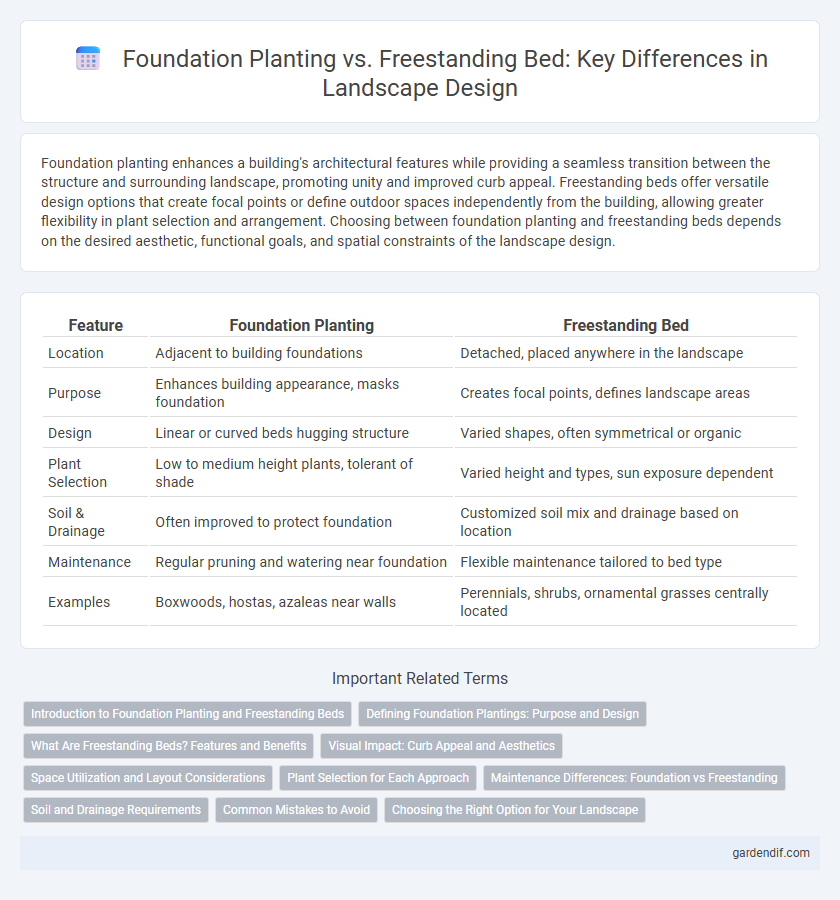
Foundation Planting vs Freestanding Bed Illustration
Foundation planting enhances a building's architectural features while providing a seamless transition between the structure and surrounding landscape, promoting unity and improved curb appeal. Freestanding beds offer versatile design options that create focal points or define outdoor spaces independently from the building, allowing greater flexibility in plant selection and arrangement. Choosing between foundation planting and freestanding beds depends on the desired aesthetic, functional goals, and spatial constraints of the landscape design.
Table of Comparison
| Feature | Foundation Planting | Freestanding Bed |
|---|---|---|
| Location | Adjacent to building foundations | Detached, placed anywhere in the landscape |
| Purpose | Enhances building appearance, masks foundation | Creates focal points, defines landscape areas |
| Design | Linear or curved beds hugging structure | Varied shapes, often symmetrical or organic |
| Plant Selection | Low to medium height plants, tolerant of shade | Varied height and types, sun exposure dependent |
| Soil & Drainage | Often improved to protect foundation | Customized soil mix and drainage based on location |
| Maintenance | Regular pruning and watering near foundation | Flexible maintenance tailored to bed type |
| Examples | Boxwoods, hostas, azaleas near walls | Perennials, shrubs, ornamental grasses centrally located |
Introduction to Foundation Planting and Freestanding Beds
Foundation planting incorporates shrubs and perennials planted directly adjacent to a building's foundation, enhancing architectural features while providing insulation and soil stabilization. Freestanding beds are isolated planting areas, designed independently from structures, allowing for diverse plant groupings and flexible landscape design. Both methods optimize space usage and contribute aesthetic and environmental benefits to outdoor landscapes.
Defining Foundation Plantings: Purpose and Design
Foundation plantings serve to soften the transition between a building and the surrounding landscape, enhancing architectural appeal while providing functional benefits such as erosion control and insulation. Typically composed of shrubs, perennials, and groundcovers, these plantings are strategically placed along the foundation, emphasizing the structure's lines and framing windows or entryways. Thoughtful design integrates plant height, texture, and seasonal interest to create a cohesive, aesthetically pleasing base that complements the home's style and scale.
What Are Freestanding Beds? Features and Benefits
Freestanding beds are isolated planting areas surrounded entirely by turf or hardscape, offering flexibility in landscape design and easy access for maintenance. These beds often feature defined edges, diverse plant groupings, and the ability to create focal points or separate garden zones without structural constraints. Their benefits include improved soil management, enhanced aesthetic appeal, and the capability to support varied plant species in a controlled environment, promoting healthy growth and visual interest.
Visual Impact: Curb Appeal and Aesthetics
Foundation planting enhances curb appeal by softening architectural lines and creating a seamless transition between the home and landscape, using shrubs and perennials that complement the structure's style. Freestanding beds provide focal points in open lawn areas, offering versatile design opportunities with seasonal color and varied textures that draw attention independently of the house. Both methods boost aesthetics but serve distinct purposes: foundation planting anchors the home visually, while freestanding beds add dynamic interest throughout the yard.
Space Utilization and Layout Considerations
Foundation planting enhances space utilization by anchoring vegetation close to building perimeters, creating seamless integration with architectural elements and maximizing limited yard areas. Freestanding beds offer flexible layout options, allowing for sculptural, focal points within open spaces and facilitating diverse plant groupings without structural constraints. Efficient landscape design balances foundation planting's linear continuity with freestanding bed's modular versatility to optimize spatial organization and aesthetic impact.
Plant Selection for Each Approach
Foundation planting benefits from selecting shrubs and perennials that thrive in partial shade and offer year-round structure, such as boxwoods, hostas, and hydrangeas, which complement architectural elements. Freestanding beds allow more flexibility with plant selection, supporting sun-loving, taller perennials like coneflowers, ornamental grasses, and daylilies, creating dynamic focal points. Choosing plants based on sunlight exposure, soil conditions, and desired visual impact ensures both foundation and freestanding beds enhance landscape aesthetics effectively.
Maintenance Differences: Foundation vs Freestanding
Foundation planting requires more frequent pruning and trimming to maintain the architectural lines close to building walls, while freestanding beds demand regular weeding and edging to preserve defined borders. Foundation beds often experience limited sunlight and airflow, increasing the need for disease management and pest monitoring compared to freestanding beds exposed to full sun and better ventilation. Watering schedules also differ, with foundation planting needing targeted irrigation to prevent water accumulation near foundations, whereas freestanding beds benefit from more evenly distributed watering techniques.
Soil and Drainage Requirements
Foundation planting requires well-drained soil with moderate moisture retention to support plant health near building structures, preventing water damage and ensuring root stability. Freestanding beds demand enhanced soil preparation with a balanced mix of organic matter and proper grading to facilitate optimal drainage and prevent waterlogging. Both methods benefit from soil amendments tailored to specific plant species, but freestanding beds offer greater flexibility in controlling soil quality and drainage conditions.
Common Mistakes to Avoid
Common mistakes in foundation planting include overcrowding plants, which restricts airflow and promotes disease, and using species unsuitable for the site's light and moisture conditions. For freestanding beds, failing to properly prepare the soil and neglecting regular maintenance such as weeding and mulching can hinder plant health and bed aesthetics. Both approaches benefit from selecting appropriate plant varieties and considering mature plant size to avoid overcrowding and maintenance challenges.
Choosing the Right Option for Your Landscape
Foundation planting enhances curb appeal by anchoring structures with shrubs and perennials that soften building edges, improving overall aesthetics and energy efficiency. Freestanding beds offer flexibility in design, allowing focal points anywhere in the landscape and accommodating diverse plant groupings without spatial constraints. Selecting the right option depends on your architectural style, garden size, maintenance preferences, and desired visual impact to create a cohesive, balanced outdoor environment.
Foundation Planting vs Freestanding Bed Infographic

 gardendif.com
gardendif.com